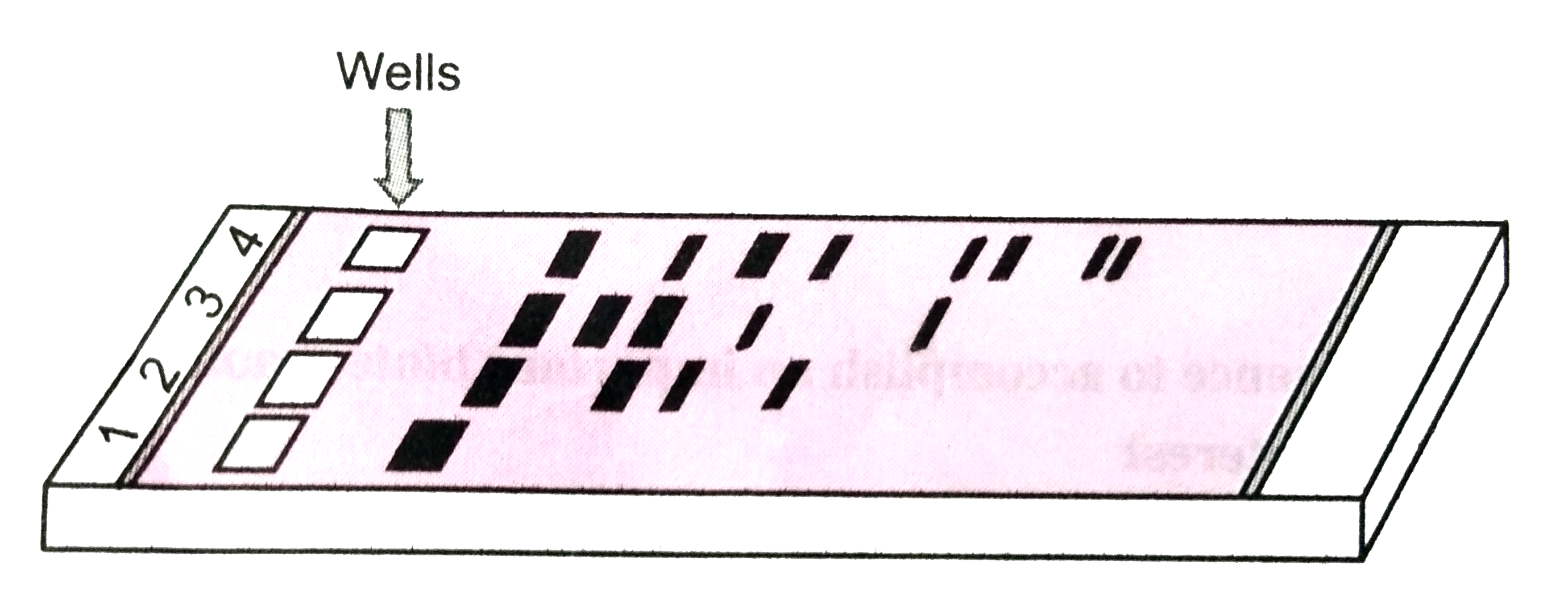Imagine a gel through which DNA fragments have moved in response to an applied electrical current.The band on this gel that is farthest from the top(that is,from the place where the DNA fragments were added to the "well")represents the
shortest fragments of DNA
longest fragments of DNA
restriction enzyme used to cut the DNA into fragments.
ligase used to bind the DNA fragments together.
To solve the question about the DNA fragments on the gel, let's break it down step by step:
Step 1: Understand the setup
In gel electrophoresis, DNA fragments are placed in a gel and an electric current is applied. The gel acts as a medium through which the DNA can move.
Hint: Remember that DNA is negatively charged due to its phosphate backbone.
Step 2: Direction of movement
When the electric current is applied, the negatively charged DNA fragments move towards the positive electrode. This movement is due to the attraction of the negative charge to the positive charge.
Hint: Think about the charges; negative moves towards positive.
Step 3: Size of DNA fragments
The movement of DNA through the gel depends on the size of the fragments. Smaller DNA fragments can navigate through the pores of the gel more easily and therefore move faster. In contrast, larger fragments encounter more resistance and move more slowly.
Hint: Consider how size affects movement through a medium.
Step 4: Identifying the farthest band
The question asks about the band that is farthest from the top of the gel, where the DNA fragments were originally loaded. Since smaller fragments move faster and travel farther in the gel, the band that is farthest from the top represents the smallest DNA fragments.
Hint: Recall that the smallest fragments travel the farthest in gel electrophoresis.
Step 5: Conclusion
Based on the understanding of how DNA fragments move in the gel, the band that is farthest from the top represents the shortest fragments of DNA.
Final Answer: The correct option is A: shortest fragments of the DNA.
In gel electrophoresis, DNA fragments are placed in a gel and an electric current is applied. The gel acts as a medium through which the DNA can move.
When the electric current is applied, the negatively charged DNA fragments move towards the positive electrode. This movement is due to the attraction of the negative charge to the positive charge.
The movement of DNA through the gel depends on the size of the fragments. Smaller DNA fragments can navigate through the pores of the gel more easily and therefore move faster. In contrast, larger fragments encounter more resistance and move more slowly.
The question asks about the band that is farthest from the top of the gel, where the DNA fragments were originally loaded. Since smaller fragments move faster and travel farther in the gel, the band that is farthest from the top represents the smallest DNA fragments.
Based on the understanding of how DNA fragments move in the gel, the band that is farthest from the top represents the shortest fragments of DNA.
Topper's Solved these Questions
Similar Questions
Why do DNA fragments move towards the anode during gel electrophoresis ?
View Solutiona) How do DNA fragments migrate and resolve in a Gel electrophoresis?
b) How lane one is different from lane 2,3 and 4 in the GEL electrophoresis set up?
c) How pure DNA fragments are made observable in the visible light?

View Solution
Knowledge Check
When DNA fragments are subjected to an electrical current on a gel, the..........fragments move to the farthest.
At-RNABLargestCSmallestDDNA libraryThe technique of extraction of DNA fragments from the gel is called:
ACentrifugationBElutionCTransfectionDGel electrophoresisA: During gel electrophoresis, the DNA fragments move towards the anode.
R: DNA fragments are negatively charged molecules .AIf both Assertion & Reason are true and the reason is the correct explanation of the assertionBIf both Assertion & Reason are true but the reason is not the correct explanation of the assertionCIf Assertion is true statement but Reason is falseDIf both Assertion and Reason are false statements
a) How do DNA fragments migrate and resolve in a Gel electrophoresis?
b) How lane one is different from lane 2,3 and 4 in the GEL electrophoresis set up?
c) How pure DNA fragments are made observable in the visible light?

View SolutionThe procedure, in which DNA fragments are separated by gel electrophoresis and then transferred on to a filter for radioactive probing is known as
View SolutionWhich of the following is used to stain an agarose gel to visualise DNA fragments?
View SolutionThe separated bands of DNA are cut out from the agarose gel and extracted from the gel piece. This step is called
View SolutionA: During gel electrophoresis, the DNA fragments move towards the anode.
R: DNA fragments are negatively charged molecules .
View Solution
